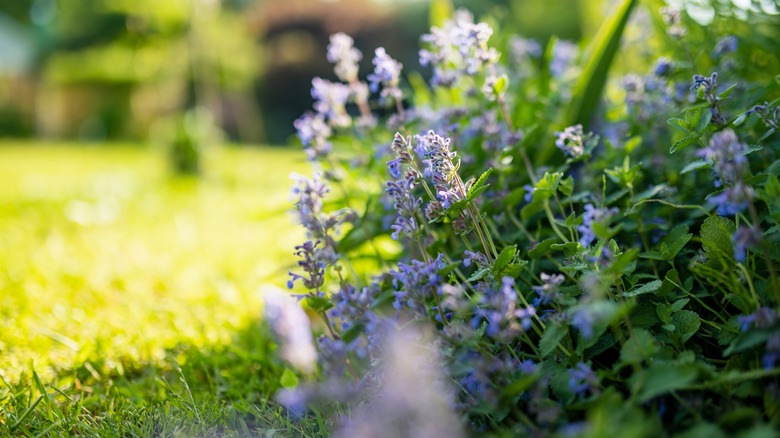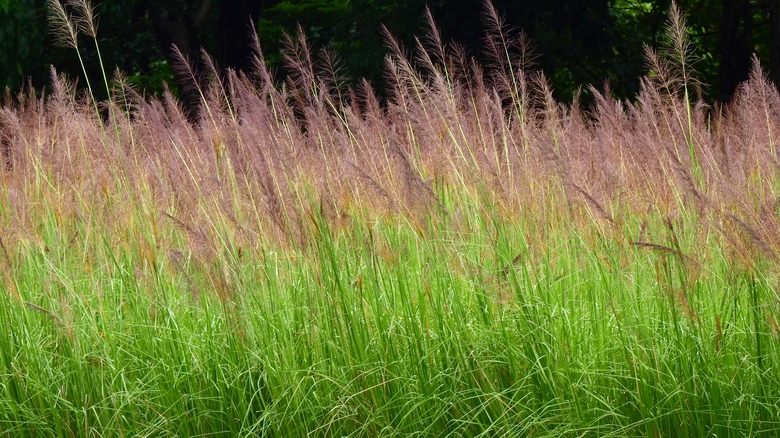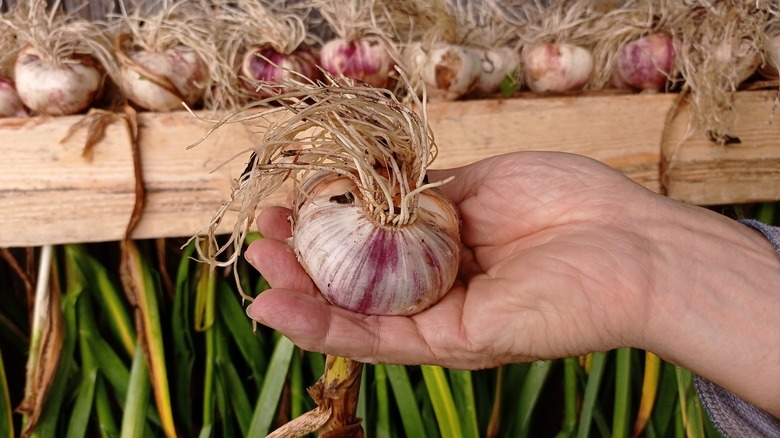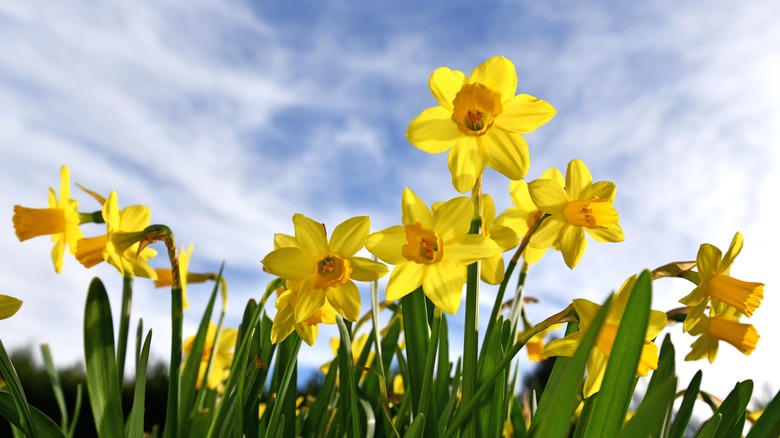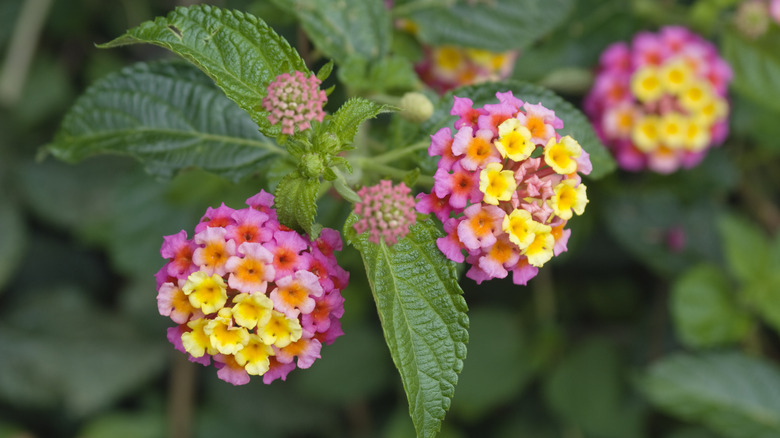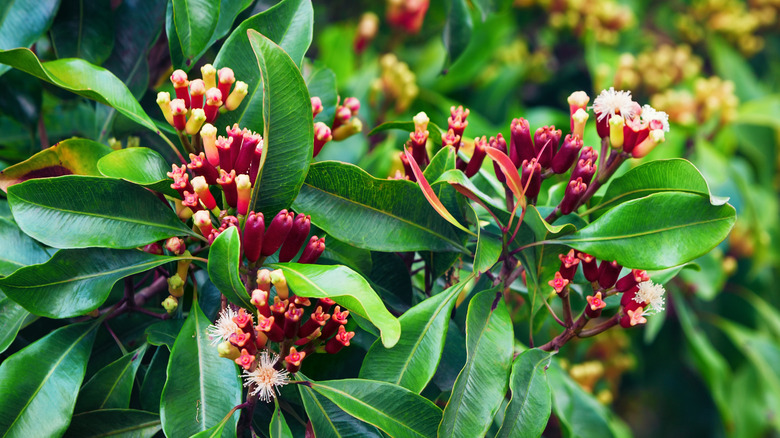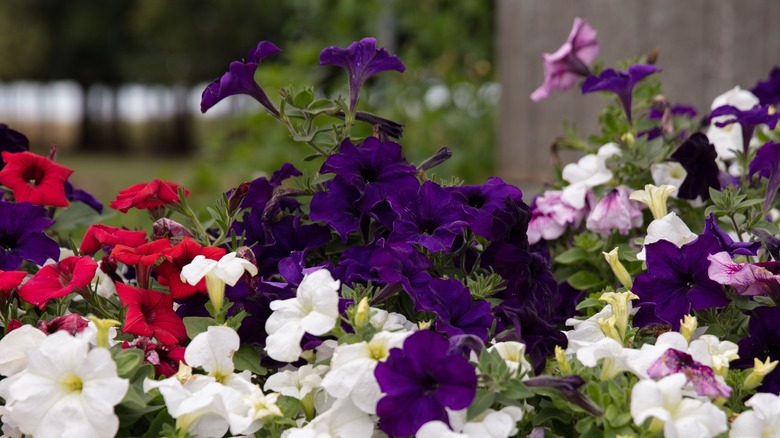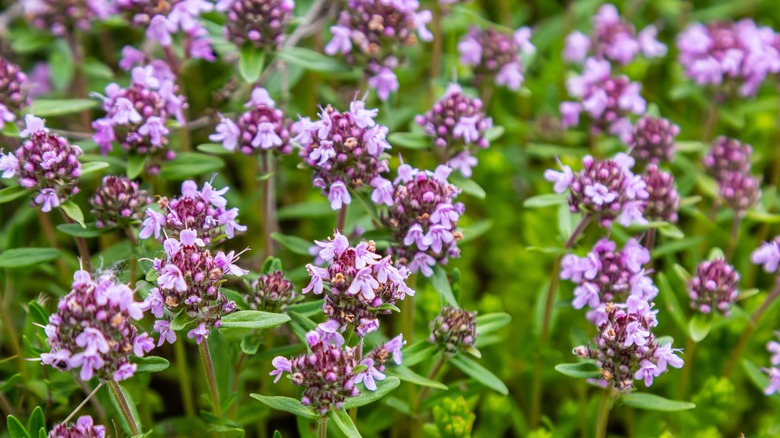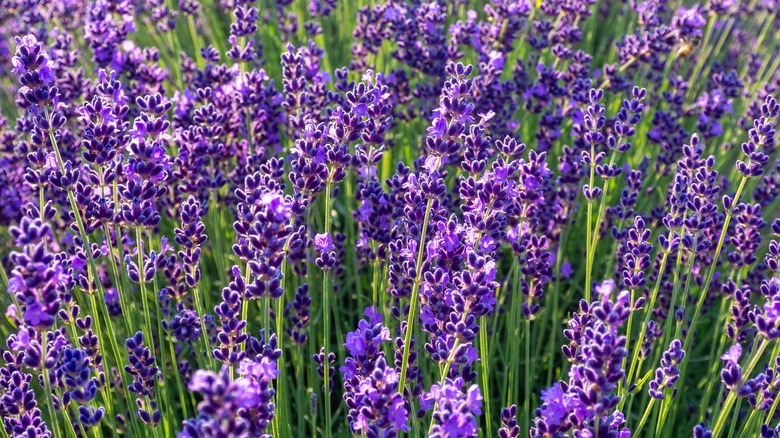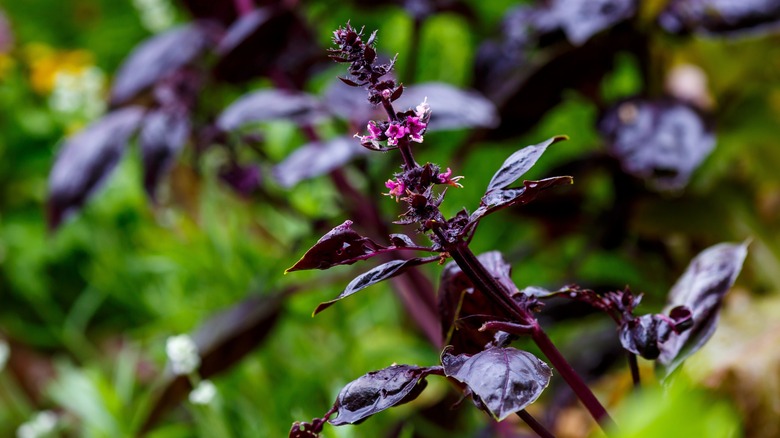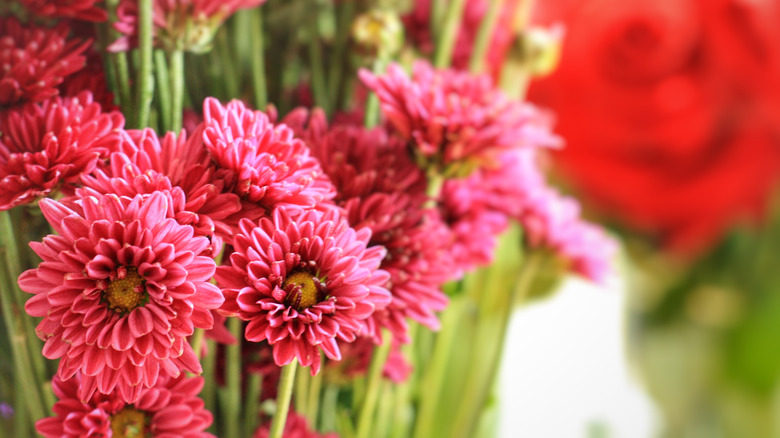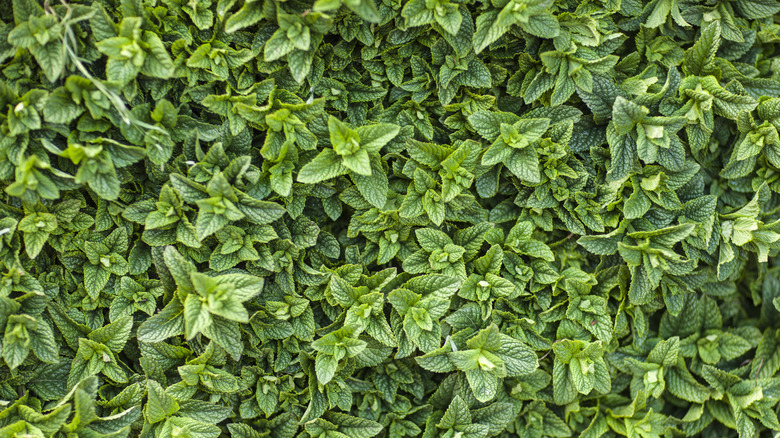13 Plants That Work As Natural Pest Control In Your Yard Or Garden
Garden pest control feels like an endless and ineffective chore sometimes. There's nothing more disappointing than coming out to your garden in the morning and finding only the destructive remains of what looks like a pest frat party all over your prized flowers and vegetables. But, before you give up on gardening forever, we're here to help with a little secret tip.
Did you know there are plants you can add to your garden that will not only look amazing but will keep pests away, too? It's true! We've picked 13 of our favorite plants that are easy to grow and will act like garden bouncers. Thanks to some of their characteristics, they can keep would-be nuisances away from the flowers, fruits, and veggies you love the most.
Catnip can deter a variety of garden pests
Catnip (Nepeta cataria) might make your cat go wild, but it's no friend to certain critters that love to munch on plants or annoy humans. Mosquitoes, flies, cockroaches, and deer are all repelled by its scent. It's so strong at telling mosquitoes to bug off (er, no pun intended) that researchers have considered its essential oil to be a comparable alternative to DEET. Take that, bloodsuckers!
Catnip can handle most soil types, just as long as it's well-draining. It prefers living somewhere that gets some afternoon shade, and it can handle some drought occasionally if it has to. Catnip is the perfect addition to any garden because honey bees and butterflies love it almost as much as your cat does. It can also live in containers just fine, making it a good choice for herb gardens and its leaves are used in recipes to add a little minty kick to dishes.
Vetiver creates discomfort for insects
Vetiver (Chrysopogon zizanioides) is a botanist nerd's dream. It's a complex grass with hundreds of compounds in its essential oil and is a powerful pest repellent, deterring ants, ticks, mosquitoes, and beetles. Plus, researchers found vetiver oil not only repelled mosquitoes but irritated them, too, which feels like a nice little tit-for-tat, doesn't it? Basically, if it's a nuisance and is considered to be part of the insect family, vetiver grass is its mortal enemy.
Vetiver is native to India, so it likes more tropical growing conditions and is hardy in USDA zones 9 to 11. It's not picky about soils and can handle a wide range of pH levels, though it does best in neutral or slightly-alkaline levels. Young plants are finicky and won't tolerate shade very well, so consider establishing them in containers before putting them in their final planting spots. Also, as a little fun fact, you may get an occasional whiff of a familiar smell when your vetiver is happy. Vetiver's oil has been used for centuries as a staple in perfumery and is one of the components you'll find in the trademark scent of Chanel No. 5.
Deer and insects avoid the pungent smell of garlic
Garlic (Allium sativum), meanwhile, may not been in perfumery but can still pack a punch with its smell. Garlic's oil has over sixteen compounds that will seriously mess an insect up, destroying its respiration and nervous systems. Beetles, aphids, and whiteflies in particular, hate garlic, while deer aren't big fans, either which makes it an excellent addition to your garden for both its pest-repelling and dish-oomphing properties.
Garlic needs well-draining soil to grow its big, beautiful cloves. It likes full sun and grows best when planted about 4 to 6 weeks before the first season's frost. Plant your garlic bulbs about two inches deep and put mulch or straw over the area to insulate them if you have rough winters. You can expect to harvest the bulbs in the late summer after planting; look for yellowish-brownish leaves to tell you when your garlic is ready.
Daffodils are a cheery way to uninvite furry guests
Daffodils (Narcissus pseudonarcissus), with their bright yellow blooms, are the cheery symbols of spring. While we might love them, they are far from a favorite of deer, rabbits, and rodents, all of which steer clear of the buttery yellow fields of flowers. Researchers found that alkaloids in the Narcissus family were so repellent that they were able to use them on other vegetation, making them too gross for pesky animals to handle. Plus, they found the alkaloids were also useful for warding off mold, fungi, and bacteria. It's like daffodils are the sweetest-looking secret bullies in the plant world and we are here for it.
Daffodils grow fast when they're grown in full sun. Their flowers will follow the sun, too, which makes them fun to watch as the days get longer. They love acidic soil and don't need much space to bloom, especially since they do well in groups. Give them some water here and there during the summers, but keep your water routine on the conservative side during their early spring growth to prevent freezing the ground or bulb rot.
Drive away pests with colorful lantana
Lantana (Lantana camara) is a double whammy for any flower garden. Not only are their blooms absolute stunners (just look at those rainbow inflorescences), but deer, mosquitoes, moths, beetles, and weevils can't stand them. Lantana flowers take a lot of things to look pretty, and its plant is chock full of goodies, like alkaloids, terpenes, and volatile compounds that run the gamut from yucky to straight-up toxic for bugs and critters.
Lantana is often grown in hanging baskets or as a houseplant, as it can get comfortable very quickly as a groundcover and aggressively compete for space with its neighbors. But, it's so pretty that you may not mind. Butterflies, hummingbirds, and other pollinators won't mind, either, as they love this plant. Lantana loves moist but well-draining soil and does best in full sun. It can handle poor soil conditions, but you might not get such showy blooms. Keep it away from pets and livestock, as it's toxic if ingested. However, we'd be remiss if we didn't point out that lantanas have a scent as stunning as their flowers, and not in a good way.
Clove is a fragrant insect deterrent
Clove (Syzygium aromaticum) isn't just a favorite spice to infuse fall baked goods. It's also an incredibly powerful oil that can make your garden thrive. One of its main components is eugenol, which is toxic to beetles, ticks, ants, cockroaches, aphids, mites, wasps, really we could go on. If it creeps, crawls, and ruins your day in the garden, cloves could probably keep it away.
Cloves grow in trees that reach anywhere from fifteen to thirty feet tall, so you'll need space to accommodate something a bit bigger than your standard shrub. The trees prefer well-draining soil that stays consistently moist and is a little on the loamy side. They do okay in most light conditions, but younger trees need a few hours in the shade to rest. If you'd like to use cloves for culinary purposes, harvest the flowers before they open. Just look for their trademark tightly wrapped cylindrical shape.
Petunias are pretty pest repellers
Is there anything prettier than a petunia? It's the second most popular annual for gardens and we can see why. Not only does it come in a swath of colors, but petunias are hardy plants that rarely deal with any major insect or disease problems. Plus, their natural scent emits a compound (methyl benzoate) that is considered by researchers to be one of the most environmentally-friendly pesticides out there. Plus, it's particularly potent against moths, stinkbugs, and is even deer resistant.
Petunias do okay in shade, but really need the full sun to give you the whole show. They're fairly tolerant of most soil conditions but need it to be well-draining above all. Deadheading will keep your petunia blooming longer and pruning leggy growth will help keep it neat and tidy. If you get their care right, you can expect it to flower all the way until the first frost, attracting butterflies and other pollinators to your garden, too.
Cannabis is showing potential as an insecticide
As cannabis (Cannabis sativa) becomes more accepted and legalized throughout the world, researchers are paying more attention to its potential pest control capabilities. A 2022 study in Cannabis and Cannabinoid Research found compounds in the C. sativa cultivar contained high toxicity levels for various species of beetles, mosquitoes, flies, and aphids. In particular, it showed impressive capabilities against the Yellow Fever Mosquito (Aedes aegypti), one of the main carriers of the Dengue and Zika viruses. While more research is needed to confirm, the field is growing yearly and points to cannabis as a potentially useful crop for eco-friendly pest control against harmful insects worldwide.
Of course, we need to stress that you should only attempt growing cannabis if it's legal to do so in your area. That said, growing the plant is a bit more complex than we can cover here as it depends on the subspecies and variety you plant to cultivate. There's also the matter of gender and cultivating seeds versus clones. Really it can get too complicated for us to sum up, so we'll leave it to the experts. Utah State University's Crop Resources Extension and Cornell Hemp School of Integrative Plant Science both have free in-depth guides that can help guide your buying and growing decisions, ensuring you get the right cultivar for your area and maintenance preferences.
Thyme can keep bunnies and deer from raviging your plants
Thyme (Thymus) is a gorgeous plant that's part of a powerful trio of pest-controlling herbs. The thymus family of plants is not only pleasing to the eyes and nose, but it's a big old nightmare to garden pests like aphids, cicadas, deer, and rabbits. Researchers studied the compounds of two strains, T. vulgaris (the most common thyme in the US) and T. proximus (a thyme common in China) and found they each contained high levels of insecticidal properties. Meanwhile, that strong aroma coats the leaves, giving thyme a key advantage in keeping the bigger critters like deer and rabbits away.
Most thymus varieties you'll find need the same growing conditions to thrive: full sun and well-draining soil. Thyme is hardy when established and will outlast most things in your garden, including maybe even your own enthusiasm. It will become your zombie plant that cannot be killed, and mowing doesn't stop it from coming back with a vengeance. It will laugh at your piddling attempt to stomp it out, and it will mock your attempt to dry it out with drought. In short, grow thyme only if you really want a lifelong plant friend. Because once it's there, it's there for good.
Lavender's scent can make unwanted visitors go elsewhere
Lavender (Lavandula), like thyme or daffodil, hides its deadly capabilities behind its cheerful, fragrant blooms. Its essential oil is full of volatiles that have been repeatedly shown to be an effective and deadly insecticide against weevils and termites. While it's not toxic to deer and rabbits, they'd prefer to deal with something a little duller on the aroma scale, thank you very much, and will head for less heavily-scented pastures.
Successfully growing lavender requires leaving it alone, which can be hard if you're a gardener who loves to check in on their plant babies. Lavender prefers well-draining, sandy soil conditions with full sun and would really prefer if you go easy on the water routine. Heavy humidity or too much water will lead to root rot quickly for lavender, so skip the mulch, too. Depending on the climate, you may want to protect it from winter conditions, especially if it's a younger plant.
Basil attracts predatory bugs as natural insect control
Basil (Ocimum basilicum) isn't your typical pest-controlling plant. While its strong aroma does deter deer and rabbits, its main benefit comes from its popularity. You see, basil isn't just delicious to us, but predatory bugs love it, too. Lacewings, in particular, are big fans of basil that seem to share a symbiotic relationship. Researchers found that female lacewing adults living near a basil plant will have not only an abundance of eggs produced but also an increased lifespan, which is handy for this next part. Because while lacewings love basil, they love aphids more and will decimate colonies easily. So, if you've got a plant that aphids love, add a basil plant next door and watch what happens next.
Basil is from the mint family so it loves similar conditions as most herbs on this list: full sun and well-draining soil that can stay a little moist. If you have trouble keeping the soil consistently moist, add a little mulch to give you some breathing room. Unfortunately, basil can't handle frosts well so many gardeners will propagate it via stem cuttings over winter and replant it in soil during the spring.
Chrysanthemums contain a natural pesticide
Chrysanthemum (Chrysanthemum spp.) is a cultivar of flower from the daisy family that's a staple of fall gardens. But mums aren't just a pretty face; they've got a cocktail of chemicals deadly to garden pests like flies, moths, mosquitoes, ants, and gnats. The cocktail is known as pyrethrins, a mixture of six different chemical compounds that occur naturally in mums. They work as a super-fast pesticide that causes a temporary paralysis in the insect, disrupting signals in the nervous system. Some bugs can break pyrethrins down and will recover before death, while others aren't so lucky.
To get the most out of your mums and their full pest-controlling capabilities, plant them next to another beneficial plant on this list. Chrysanthemums are relatively easygoing plants, preferring full sun, but can handle a little shade here and there. They like well-draining soil that's full of high organic content, so add some worm castings or biochar if your soil is naturally bland. Most mums will be perennial, but there are others that are prima donnas about coming back; it just depends on the variety.
Mint makes deer and insects leave
The mint (Mentha) family is the workhorse of the plant world for pest control. These clean-smelling herbs help manage pests thanks to being the holders of volatile organic compounds (VOCs) that are the OGs of pesticide management: monoterpenes and sesquiterpenes. These include menthol and limonene, powerful chemicals that have proven capabilities for repelling moths, thrips, flies, and aphids. Plus, while deer are turned off by their strong scents, pollinators adore them, making any mint you pick an excellent addition to your garden.
That said, be careful planting mint, as it can take over quickly if you let it go. Regular mint strains love full sun and moist soil that's slightly acidic, but it's prone to diseases and root rot if things get too soggy. Keep your mint plant in a container or be prepared to trim it back regularly, or it will become the best-smelling invasive plant you've ever had.

